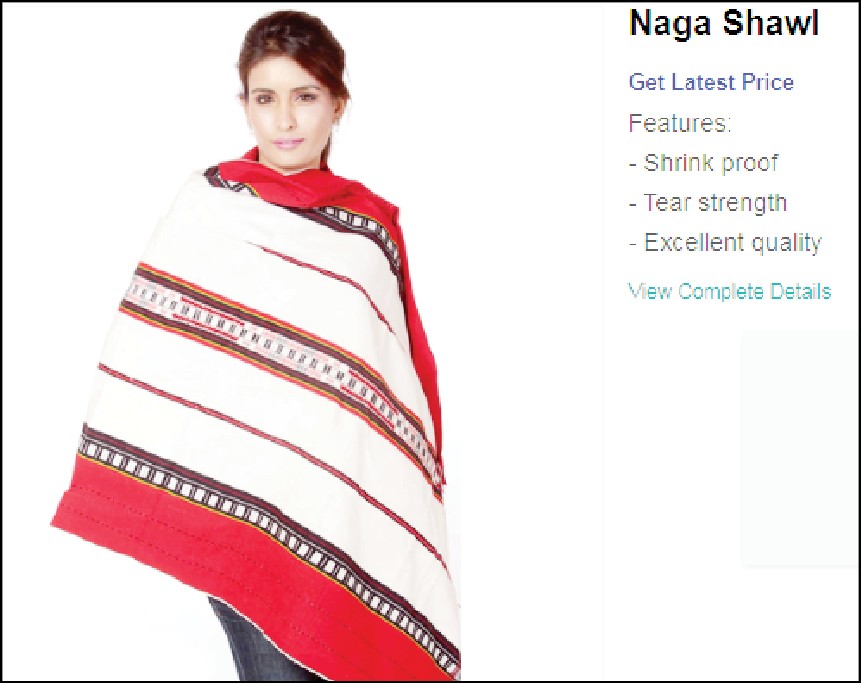Sangeeta Sillk & Saree House, based in Sibsagar, Assam, also sells ‘traditional Naga shawls’ on indiamart.com, one of which is the GI tagged Chakhesang Rura.

NHHDC mulling state textile policy
Veroli Zhimo
Dimapur | September 3
The Nagas take pride in their rich culture and are cautious over any attempt of misappropriation of their cultural heritage.
However, in the recent past, several instances of ‘cultural plagiarism’ especially of traditional Naga shawls underscore the reality that there is much to be done to protect the shawls which give their people their distinct identities as a clan or a tribe.
Among the many challenges with regard to preserving and protecting culture, mass production and plagiarism by entities outside the state poses a great risk for indigenous communities whose identities and heritage are deeply embedded in this ‘social fabric.’
Take for example the “Tribal Crafts Beautiful and Traditional Naga Chaddar, Shawl, Very Very Warm Woolen Naga chaddar” sold by Tribal Crafts India on Amazon shopping site. Although listed on the site, the red shawl with black and white stripes resembling traditional Naga shawls is ‘currently unavailable’ for order. Another shawl bearing uncanny resemblance to the Ao ‘Tsungkotepsu’ shawl is also being sold by the same company was initially listed for Rs 9,000 but is also currently unavailable.
The same seller also listed another shawl labelled as “Tribal Crafts Women’s Wool Shawl (Red, black, green, yellow & white)” which bears resemblance to the Chakhesang Rura shawl which is protected under the Geographical Indications of Goods (Registration and Protection) Act, 1999. This shawl is listed for Rs 9,000 on Amazon and is currently on sale at a discounted price of Rs 2,398. Other designs sold by the same seller also resemble the Lohe shawl, worn by the Angami and Chakhesang Nagas.
Several other shawls that bear resemblance to traditional Naga shawls are up for sale not only on Amazon but also other online stores.
indiamart.com also has a variety of ‘Naga shawls’ marketed by a Ludhiana based ‘Luxmi Trading’ which defined itself as “a leading Manufacturer and Trader of a wide range of Ladies Shawl, Ladies Scarf, Manipuri Lungi, etc.” The shawls sold by this trader ranges from Rs 350 upwards.
Another seller—Sangeeta Sillk & Saree House, based in Sibsagar, Assam, also sells ‘traditional Naga shawls’ on indiamart.com, one of which is almost identical to the GI tagged Chakhesang Rura.
Speaking to The Morung Express on Friday, Chairperson of the Nagaland Handloom and Handicrafts Development Corporation (NHHDC) Ltd Miathou Krose noted that such misappropriation of Naga textile was ‘a very serious matter.’
Krose lamented that the state has gone straight to promotion and the commercial aspect of marketing products without the protection that is required. Stating that shawls cannot be used ‘cheaply,’ the Chairperson elucidated that there is a story behind every design and motif in the shawls and the shawls are greatly valued in Naga society. “This is our identity,” he asserted.
With regard to the products on Amazon and indiamart.com, Krose said that the NHHDC would first reach out to the respective tribes and enquire if they have given their approval and take the matter up. The Chakhesang people have already GI tagged their shawls, so we will get in touch with the concerned people and see what we can do, he added.
Referring to a recent incident with the launch of a new collection by Indian fashion brand Fabindia earlier in August, Krose noted that a certain level of awareness has been created among the populace. While we don’t know whether the general public is taking it seriously, this is not a small matter and it involves all the communities and tribes of Nagaland, he added.
According to him, the problem is there are so many business people or entrepreneurs who are tying up with outsiders and the corporation cannot keep a check on all of them. In this regard, he said that the corporation has been considering formulating a textile policy or even a regulatory authority so that these issues do not crop up again.
“The matter will be taken up with the Chief Minister,” he added.
Stating that the NHHDC is only a corporation and not even a regular department Krose also informed that earlier in 2019, a proposal was made to the sericulture department to expand the sericulture department into a department of textiles. However, it has not materialised till date.
Nonetheless, he reiterated that the corporation is “very much concerned” about the issues and said that the matter would be taken up to the highest level in the government.
“There is no doubt that we need to do something. We have already created some awareness and we’ll keep the ball rolling. But this needs a collective effort not only from the government’s side but the communities’ contribution also,” Krose said.






